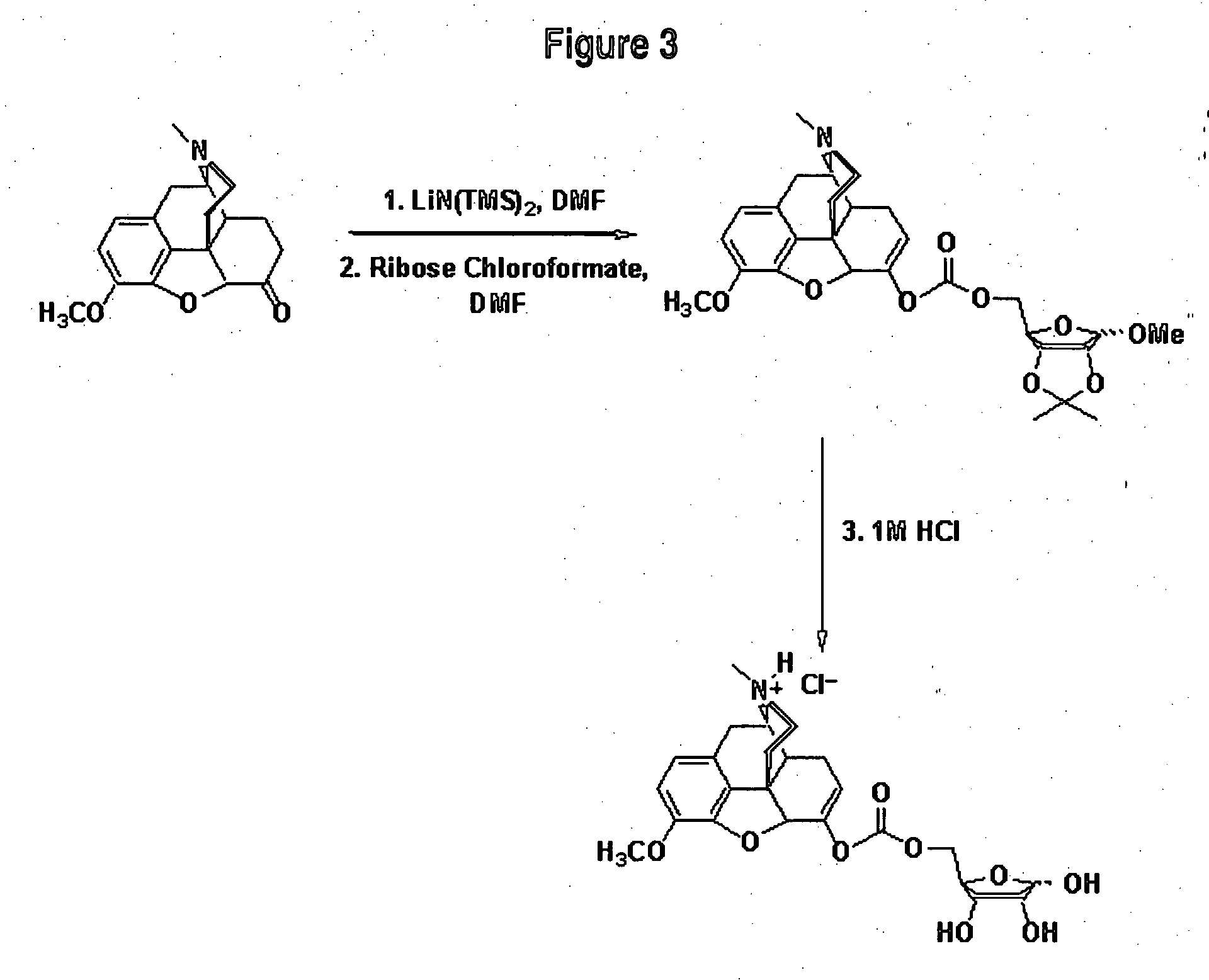Pharmaceutical compositions for prevention of overdose or abuse
a technology of pharmaceutical compositions and compositions, applied in the direction of pharmaceutical delivery mechanisms, organic active ingredients, peptide/protein ingredients, etc., can solve the problems of drug dependence of the morphine type, accidental overdose, and significant and growing problem of drug overdos
- Summary
- Abstract
- Description
- Claims
- Application Information
AI Technical Summary
Problems solved by technology
Method used
Image
Examples
examples
The invention is illustrated by pharmacokinetic studies with hydrocodone and oxycodone that have been covalently modified by attachment to various moieties such as an individual amino acid, specific short chained amino acid sequences such as di-, tri-, and pentapeptides, or carbohydrates such as ribose, etc. Studies include pharmacokinetic evaluations of the various drug conjugates administered by the oral, intranasal, and intravenous routes. Collectively the compounds demonstrate that active agents may be modified by covalent attachment to various moieties and retain their therapeutic value at normal doses while preventing potential overdose by oral administration and prevention of abuse through intranasal and intravenous administration.
Carrier Bound Compounds
Examples 1 through 51
Applicability of Abuse Resistance for the Narcotic Analgesics Demonstrated Through the Use of Hydrocodone.
examples 1 through 51
illustrate the applicability of a number of peptide-active agent compositions in reducing the potential for overdose while maintaining their therapeutic value wherein the peptides are conjugated to the active agent hydrocodone (HC). Exemplary compounds which were substituted at the 6 position of hydrocodone are termed EEFFI-HC, EEFFF-HC, YYI-HC, DDI-HC, and YYFFI-HC.
Oral, intranasal, and intravenous bioavailability studies of hydrocodone and hydrocodone conjugates were conducted in male Sprague-Dawley rats. Doses of hydrocodone bitartrate and hydrocodone conjugates containing equivalent amounts of hydrocodone were administered in deionized water. Oral administration was in 0.5 ml by gavage needle (with the exception of YYI-HC, which was delivered as a solid in gelatin capsules). Intranasal doses were administered by placing 20 microliters into the nasal flares of rats anesthetized with isoflurane. Intravenous administration was in 0.1 ml by tail vein injection. Plasma was collected...
example 1
Galacto-Hydrocodone
FIG. 1 illustrates preparation of Galacto-Hydrocodone.
ReagentsMWWeightmmolesMolar Equivalents1. Hydrocodone2990.223g0.751.01. LiN(TMS)2 in THF1M1.13ml1.131.51. DMF—5ml——2. Galactose——1.492.0Chloroformate2. DMF—3ml——3. 1M HCl1M30ml——3. Acetone—20ml——
Galacto-Hydrocodone
To a solution of hydrocodone in DMF was added LiN(TMS)2 in THF via syringe. The solution was stirred at ambient temperatures for 5 minutes then the chloroformate of galactose in DMF was added via syringe. The resulting solution was stirred at ambient temperatures for 2 hours. A TLC was taken (9:1 CHCl3:MeOH; UV and 5% H2SO4 in MeOH; Rf(product)=˜0.5). Reaction was neutralized to pH 7 with 6M HCl. Solvent was removed. Final product was purified using preparative TLC (0-10% MeOH in CHCl3). Solid was collected as a white powder (0.180 g, 41% yield): 1H NMR (DMSO-d6) δ 1.28 (2s, 6H), 1.37 (s, 3H), 1.44 (3, 3H), 1.49 (m, 2H), 1.88 (dt, 1H), 2.08 (m, 2H), 2.29 (s, 4H), 2.40 (m, 2H), 2.90 (d, 1H), 3.09...
PUM
| Property | Measurement | Unit |
|---|---|---|
| Mass | aaaaa | aaaaa |
| Mass | aaaaa | aaaaa |
| Mass | aaaaa | aaaaa |
Abstract
Description
Claims
Application Information
 Login to View More
Login to View More - R&D
- Intellectual Property
- Life Sciences
- Materials
- Tech Scout
- Unparalleled Data Quality
- Higher Quality Content
- 60% Fewer Hallucinations
Browse by: Latest US Patents, China's latest patents, Technical Efficacy Thesaurus, Application Domain, Technology Topic, Popular Technical Reports.
© 2025 PatSnap. All rights reserved.Legal|Privacy policy|Modern Slavery Act Transparency Statement|Sitemap|About US| Contact US: help@patsnap.com



